Zanussi W802 User Manual [ru]
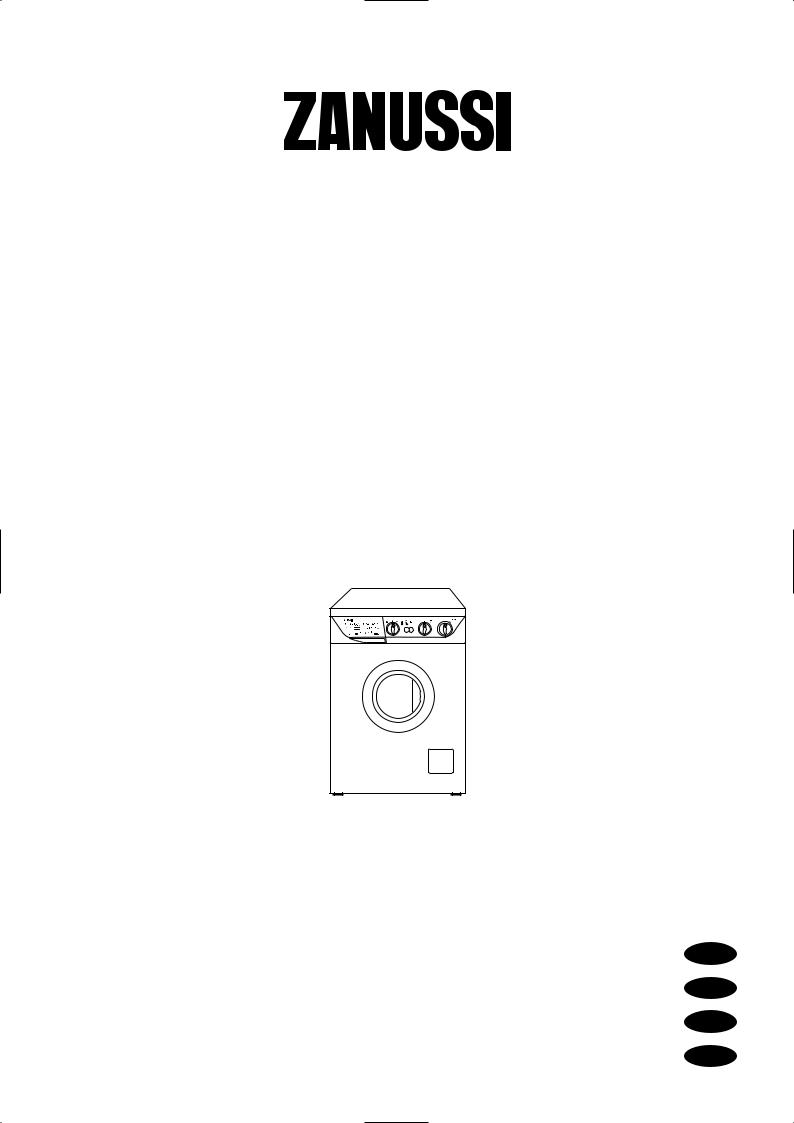
WASHER-DRYER
TVƒTT-/TORKMASKIN
PESU-/KUIVAUSKONE
STIRALWNO-SUfiILWNAÅ MAfiINA
W802
INSTRUCTION BOOKLET BRUKSANVISNING KƒYTT÷OHJE
GB
S
FIN
132995520 |
RUKOVODSTVO PO ÈKSPLUATACII |
RUS |
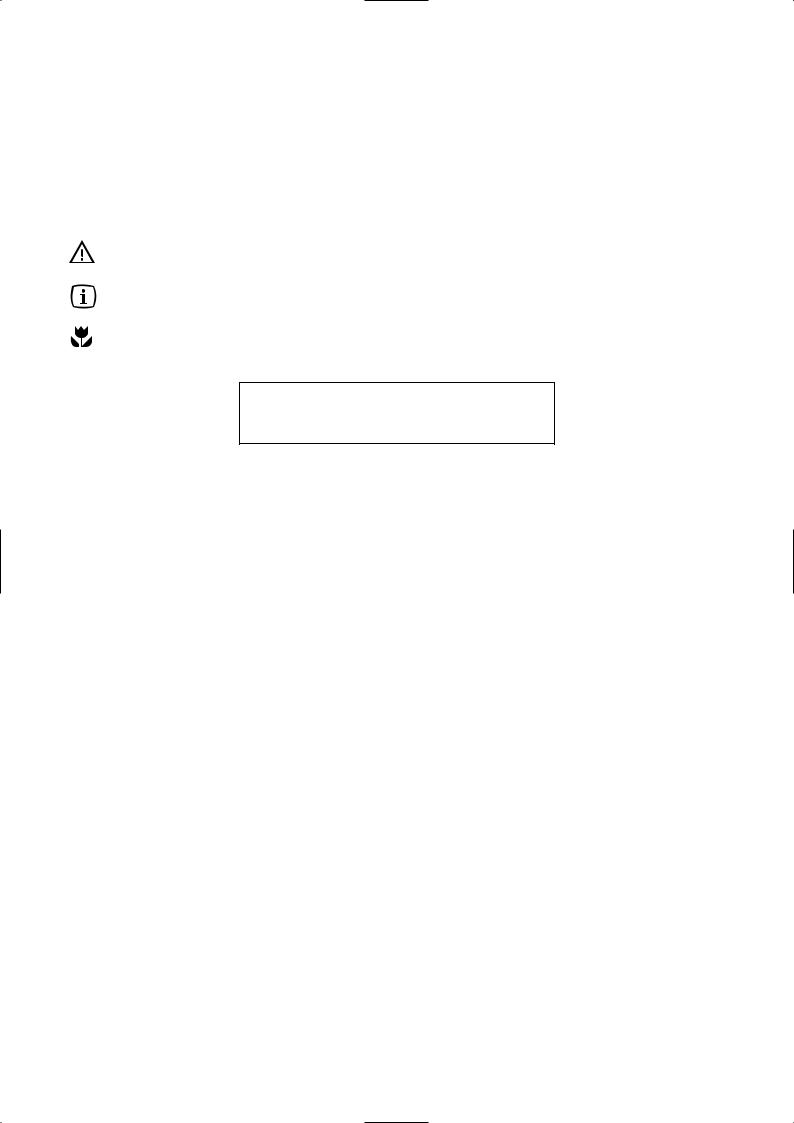
Dear customer,
Please read these operating instructions carefully and pay particular attention to the safety notes indicated in the first pages. We recommend that you keep this instruction booklet for future reference and pass it on to any future owners.
Transport damages
When unpacking the appliance, check that it is not damaged. If in doubt, do not use it and contact the Service Centre.
The symbols you will see on some paragraphs of this booklet have the following meaning:
The warning triangle and/or the key words (Warning!, Caution!) emphasize information that is particularly important for your safety or correct functioning of the appliance.
The information marked with this symbol provides additional instructions and practical tips on the use of the appliance.
Tips and information about economical and ecological use of the machine are marked with this symbol.
Our contribution to the protection of the environment: we use environmentally friendly paper.
Contents
Warnings
Disposal
Tips for environmental protection
Technical specifications
Installation
Unpacking
Positioning
Water inlet
Water drainage
Electrical connection
Your new washer-dryer
Description of the appliance
Detergent dispenser drawer
Use
Control panel
Controls
Washing hints
Sorting the laundry
Temperatures
Before loading the laundry
Maximum loads
4-5 |
Laundry weights |
11 |
|
|
Removing stains |
11 |
|
5 |
Detergents and additives |
12 |
|
|
Drying hints |
13 |
|
5 |
Load |
13 |
|
6 |
Garments not suitable for drying |
13 |
|
Drying symbols on garment labels |
13 |
||
7 |
Duration of the drying cycle |
13 |
|
Fibre residue |
13 |
||
|
|||
7 |
Additional drying |
13 |
|
7 |
International wash code symbols |
14 |
|
7 |
Operating sequence |
15-17 |
|
8 |
Washing only |
15-16 |
|
8 |
Drying only |
17 |
|
9 |
Automatic washing and drying |
17 |
|
9 |
Washing programmes |
18-19 |
|
Drying programmes |
20 |
||
|
|||
9 |
Maintenance |
21 |
|
|
|||
10 |
Bodywork |
21 |
|
10 |
Detergent dispenser drawer |
21 |
|
10 |
Drain filter |
21 |
|
11 |
Water inlet filter |
21 |
|
11 |
Emergency emptying out |
22 |
|
11 |
Frost precautions |
22 |
|
11 |
Something not working? |
23-24 |
|
11 |
2

 Warnings
Warnings
The following warnings are provided in the interests of overall safety. You must read them carefully before installing or using the appliance.
Installation
ïAll internal packing must be removed before using the appliance. Serious damage may be caused to the machine or adjacent furniture if the protective transit devices are not removed or are not completely removed. Refer to the relevant paragraph in the instruction book.
ïAny electrical work required to install this appliance must be carried out by a qualified electrician.
ïAny plumbing work required to install this appliance must be carried out by a qualified plumber.
ïAfter having installed the machine, check that it is not standing on its electrical supply cable.
ïIf the appliance is placed on a carpeted floor, ensure that air can circulate freely between the feet and the floor.
Use
ïThis appliance is designed for domestic use. It must not be used for purposes other than those for which it was designed.
ïOnly wash and dry fabrics which are designed to be machine washed and dried. Follow the instructions on each garment label.
ïDo not overload the appliance. Follow the instructions in the instruction book.
ïMake sure that all pockets are empty. Objects such as coins, safety pins, pins and screws can cause extensive damage.
ïDo not machine wash garments saturated with petroleum, methylated spirits, trichlorethylene, etc. If such fluids have been used to remove stains prior to washing, wait until they have completely evaporated from the fabric before placing garments in the appliance.
ïPlace small items such as socks, belts, etc. in a cloth bag or pillowcase to prevent them getting trapped between the drum and the tub.
ïIf you use a liquid detergent with a dispenser which has to be placed directly in the drum, remember to remove this dispenser before drying.
ïUse only the recommended quantities of fabric softener. An excessive amount could damage the laundry.
ïLeave the porthole door slightly ajar when the appliance is not in use. This preserves the door seal and prevents the formation of musty smells.
ïAlways check that water has emptied out before opening the door. If not, drain the water following the instructions in the instruction book.
ïAlways unplug the appliance and shut the water tap after use.
General safety
ïRepairs to the machine must be carried out only by qualified personnel. Repairs carried out by inexperienced persons could cause serious danger. Contact your local Service Centre.
ïNever pull the power supply cable to remove the plug from the socket; always take hold of the plug itself.
ïDuring high temperature wash programmes and during the drying cycle the door glass may get hot. Do not touch it!
Child safety
ïChildren are often not aware of how dangerous electrical appliances can be. When the machine is working, children should be carefully supervised and not be allowed to play with the appliance.
ïThe packaging components (e.g. plastic film, polystyrene) can be dangerous to children - danger of suffocation! Keep them out of childrenís reach.
ïKeep all detergents in a safe place out of childrenís reach.
ïMake sure that children or pets do not climb into the drum.
ïWhen the appliance is to be scrapped, cut off the electrical supply cable and destroy the plug with the remaining cable. Disable the door catch in order to prevent children from becoming trapped inside while playing.
ENGLISH
3

 Disposal
Disposal
Packaging materials
The materials marked with the symbol 
 are recyclable.
are recyclable.
>PE<=polyethylene >PS<=polystyrene >PP<=polypropylene
This means that they can be recycled by disposing of them properly in appropriate collection containers.
Machine
Use authorised disposal sites for your old appliance. Help to keep your country tidy!
 Tips for environmental protection
Tips for environmental protection
To save water, energy and to help protect the environment, we recommend that you follow these tips:
ïNormally soiled laundry may be washed without prewashing in order to save detergent, water and time (the environment is protected too!).
ïThe machine works more economically if it is fully loaded (for both washing and drying cycles).
ïThe machine will consume less energy if the laundry is adequately spun before being dried.
ïWith adequate pre-treatment, stains and limited soiling can be removed; the laundry can then be washed at a lower temperature.
ïMeasure out detergent according to the water hardness, the degree of soiling and the quantity of laundry being washed.
Technical specifications
DIMENSIONS |
Height |
85 cm |
|
|
Width |
60 cm |
|
|
Depth |
58 cm |
|
|
|
|
|
|
|
WASHING |
DRYING |
MAXIMUM LOAD |
Cotton |
5 kg |
2.5 kg |
|
Synthetics |
2.5 kg |
2.0 kg |
|
Delicates |
2.5 kg |
- |
|
Woollens |
2 kg |
- |
|
|
|
|
SPIN SPEED |
|
850 rpm max. |
|
|
|
||
POWER SUPPLY VOLTAGE/FREQUENCY |
220-230 V/50 Hz |
||
TOTAL POWER ABSORBED |
|
2200 W |
|
MINIMUM FUSE PROTECTION |
|
10 A |
|
|
|
|
|
WATER PRESSURE |
Minimum |
500 kPa |
|
|
Maximum |
800 kPa |
|
This appliance complies with the following EEC Directives: 73/23/EEC of 19/02/73 relating to low voltage
89/336/EEC of 03/05/89 relating to electromagnetic compatibility.
4
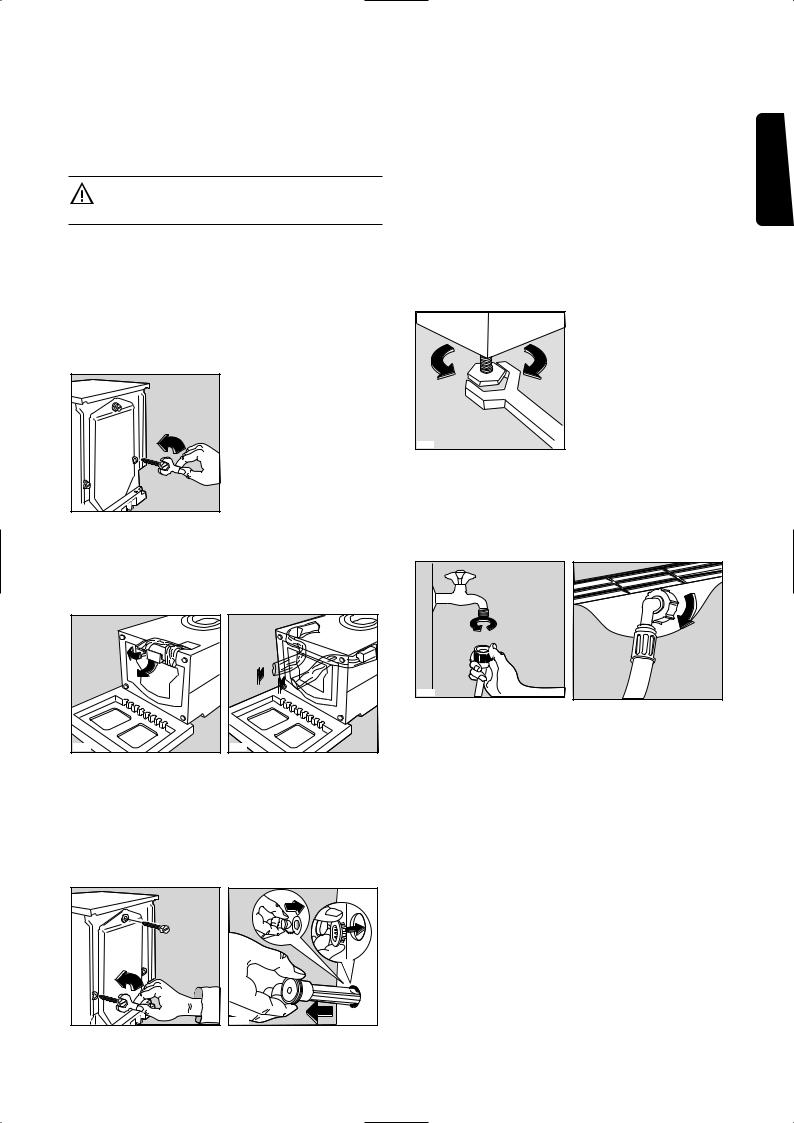
Installation
Unpacking
All transit bolts and packing must be removed before using the appliance.
You are advised to keep all transit devices so that they can be refitted if the machine ever has to be transported again.
1.Using a spanner, unscrew and remove the rear right-hand bolt and lay the machine on its back, taking care not to squash the hoses. This can be avoided by placing one of the corner packing pieces between the machine and the floor.
P0255 |
2.Remove the polystyrene block from the underside of the machine and release the two plastic bags.
3.Carefully remove the right-hand bag (1) then the left-hand bag (2) by pulling them towards the centre of the machine.
P1068 |
2 |
1 |
P1066 |
|
4.Set the machine upright and remove the two remaining bolts from the back.
5.Pull out the three plastic spacers from the holes into which the bolts were fitted.
6.Plug the open holes with the plugs which are supplied with the instruction booklet.
P0256 |
P0020 |
Positioning
Install the machine on a flat hard floor.
Make sure that air circulation around the machine is not impeded by carpets, rugs etc. Check that the machine does not touch the wall or other kitchen units. Carefully level by screwing the adjustable feet in or out. Never place cardboard, wood or similar materials under the machine to compensate for any unevenness in the floor.
P1051 |
Water inlet
Connect the water inlet hose supplied with the machine to a tap with a 3/4" thread.
Do not use already employed hoses.
P1088 |
P0021 |
The other end of the inlet hose which connects to the machine can be turned in any direction. Simply loosen the fitting, rotate the hose and retighten the fitting, making sure there are no water leaks.
The inlet hose must not be lengthened. If it is too short and you do not wish to move the tap, you will have to purchase a new, longer hose specially designed for this type of use.
Water drainage
The end of the drain hose can be positioned in three ways:
Hooked over the edge of a sink using the plastic hose guide supplied with the machine. In this case, make sure the end cannot come unhooked when the machine is emptying.
ENGLISH
5
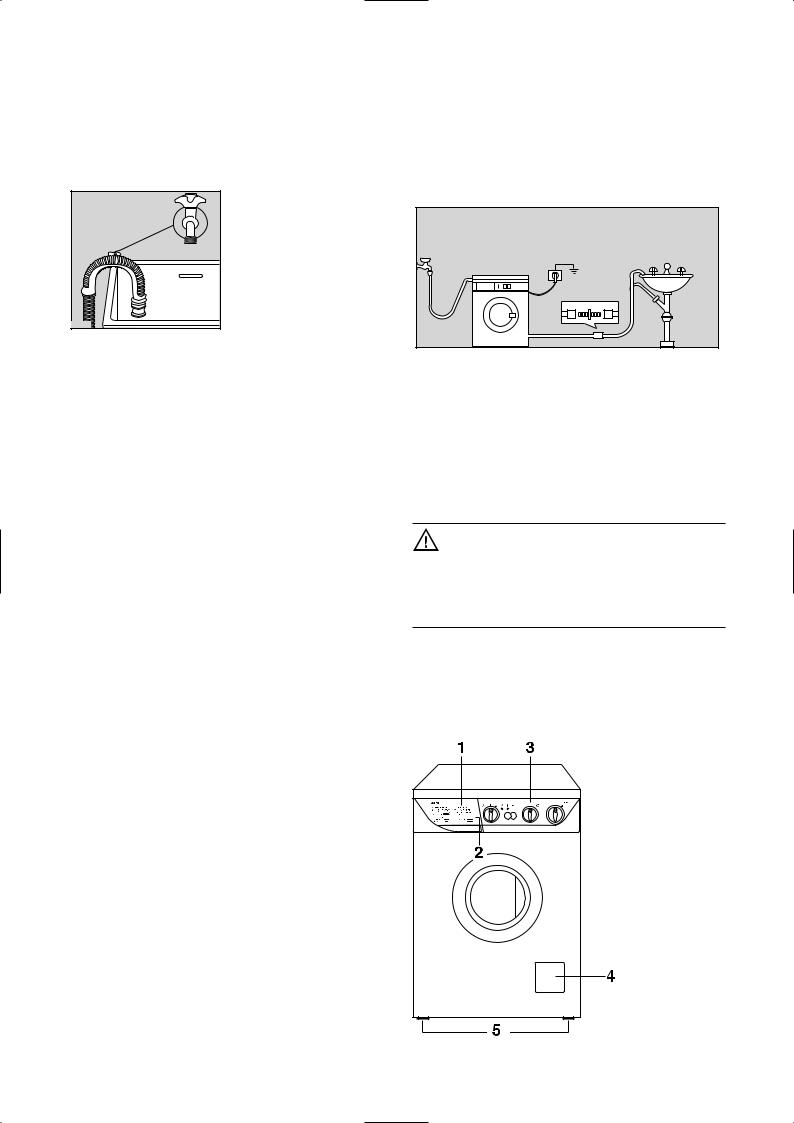
This could be done by tying it to the tap with a piece of string or attaching it to the wall.
P0022 |
In a sink drain pipe branch. This branch must be above the trap so that the bend is at least 60 cm above the ground.
Directly into a drain pipe at a height of not less than 60 cm and not more than 90 cm.
The end of the drain hose must always be ventilated, i.e. the inside diameter of the drain pipe must be larger than the outside diameter of the drain hose.
Description of the appliance
1 Detergent dispenser drawer
2 Programme chart
3 Control panel
4 Drain filter
5 Adjustable feet
The drain hose must not be kinked. Run it along the floor; only the part near the drainage point must be raised.
P0023 |
Electrical connection
This machine is designed to operate on a 220-230 V, single-phase, 50 Hz supply.
Check that your domestic electrical installation can take the maximum load required (2.2 kW), also taking into account any other appliances in use.
Connect the machine to an earthed socket.
The manufacturer declines any responsibility for damage or injury through failure to comply with the above safety precaution.
Should the appliance power supply cable need to be replaced, this should be carried out by our Service Centre.
The power supply cable must be easily accessible after installing the machine.
6
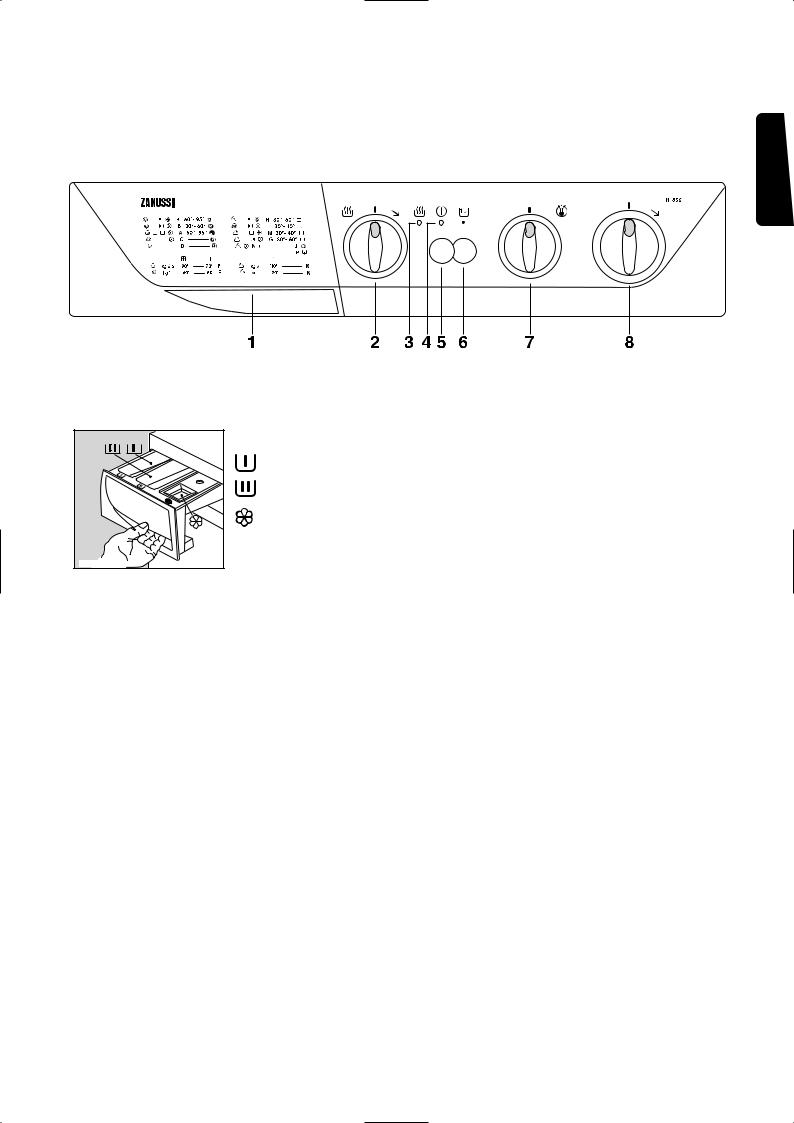
Use
Control panel
ENGLISH
1 Detergent dispenser drawer
Prewash
Main wash
Fabric softener, starch
C0063
4 Mains-on light
This light illuminates when the machine starts working and goes out when the ON/OFF button is released.
5 On/Off button 
By depressing this button the machine starts operating.
When depressed again, the machine stops.
2 Drying time selector dial 
Graduated up to 120 mins for cottons (black section) and synthetics (grey section), this dial allows you to select the desired drying time according to the type and quantity of laundry and the required degree of dryness.
Turn the dial clockwise only.
Cooling phase
To allow the laundry to cool down, a cooling phase starts automatically 10 minutes before the end of drying and this phase must in no circumstances be reduced or interrupted.
3 Drying indicator light 
This light illuminates when the machine is drying.
6 Half load 
Select this button to reduce water consumption on the rinse cycle when washing a half load of cottons or linens.
7 Temperature selector dial 
Turn this dial clockwise or anti-clockwise to select the required temperature.
Position  means that the machine will wash with cold water.
means that the machine will wash with cold water.
8 Programme selector dial
Turn the dial clockwise to select the required wash and drying programme.
Before setting the dial to any position the machine must be switched off by depressing the ON/OFF button again.
7

Washing hints
Sorting the laundry
Follow the wash code symbols on each garment label and the manufacturerís washing instructions. Sort the laundry as follows:
whites, coloureds, synthetics, delicates, woollens.
Temperatures
95° for normally soiled white cottons and linen (e.g. tea cloths, towels, tablecloths, sheets...)
60° for normally soiled, colour fast garments (e.g. shirts, night dresses, pyjamas....) in linen, cotton or synthetic fibres and for lightly soiled white cotton (e.g. underwear).
 (cold)for delicate items (e.g. net curtains), mixed
(cold)for delicate items (e.g. net curtains), mixed
30°-40° laundry including synthetic fibres and woollens.
The wool wash cycle of this machine has been approved by Woolmark for the washing of machine washable Woolmark products provided that the garments are washed according to the instructions on the garment label and those issued by the manufacturer of this washing machine. M9604.
Before loading the laundry
Never wash whites and coloureds together. Whites may lose their ìwhitenessî in the wash.
New coloured items may run in the first wash; they should therefore be washed separately the first time.
Make sure that no metal objects are left in the laundry (e.g. hair clips, safety pins, pins).
Button up pillowcases, close zip fasteners, hooks and poppers. Tie any belts or long tapes.
Remove persistent stains before washing. Rub particularly soiled areas with a special detergent or detergent paste.
Treat curtains with special care. Remove hooks or tie them up in a bag or net.
Maximum loads
Recommended loads are indicated in the programme charts.
General rules:
Cotton, linen: drum full but not too tightly packed; Synthetics: drum no more than half full;
Delicate fabrics and woollens: drum no more than one third full.
Washing a maximum load makes the most efficient use of water and energy.
For heavily soiled laundry, reduce the load size.
Laundry weights
The following weights are indicative: |
|
bathrobe |
1200 g |
napkin |
100 g |
quilt cover |
700 g |
sheet |
500 g |
pillow case |
200 g |
tablecloth |
250 g |
towelling towel |
200 g |
tea cloth |
100 g |
night dress |
200 g |
ladiesí briefs |
100 g |
manís work shirt |
600 g |
manís shirt |
200 g |
manís pyjamas |
500 g |
blouse |
100 g |
menís underpants |
100 g |
Removing stains
Stubborn stains may not be removed by just water and detergent. It is therefore advisable to treat them prior to washing.
Blood: treat fresh stains with cold water. For dried stains, soak overnight in water with a special detergent then rub in the soap and water.
Oil based paint: moisten with benzine stain remover, lay the garment on a soft cloth and dab the stain; treat several times.
Dried grease stains: moisten with turpentine, lay the garment on a soft surface and dab the stain with the fingertips and a cotton cloth.
Rust: oxalic acid dissolved in hot water or a rust removing product used cold. Be careful with rust stains which are not recent since the cellulose structure will already have been damaged and the fabric tends to hole.
Mould stains: treat with bleach, rinse well (whites and fast coloureds only).
Grass: soap lightly and treat with bleach (whites and fast coloureds only).
Ball point pen and glue: moisten with acetone (*), lay the garment on a soft cloth and dab the stain.
8

Lipstick: moisten with acetone as above, then treat stains with methylated spirits. Remove any residual marks from white fabrics with bleach.
Red wine: soak in water and detergent, rinse and treat with acetic or citric acid, then rinse. Treat any residual marks with bleach.
Ink: depending on the type of ink, moisten the fabric first with acetone (*), then with acetic acid; treat any residual marks on white fabrics with bleach and then rinse thoroughly.
Tar stains: first treat with stain remover, methylated spirits or benzine, then rub with detergent paste.
(*) do not use acetone on artificial silk.
Detergents and additives
Good washing results also depend on the choice of detergent and use of the correct quantities to avoid waste and protect the environment. Although biodegradable, detergents contain substances which, in large quantities, can upset the delicate balance of nature.
The choice of detergent will depend on the type of fabric (delicates, woollens, cottons, etc.), the colour, washing temperature and degree of soiling.
All commonly available washing machine detergents may be used in this appliance:
ñpowder detergents for all types of fabric,
ñpowder detergents for delicate fabrics (60°C max) and woollens,
ñliquid detergents, preferably for low temperature wash programmes (60°C max) for all types of fabric, or special for woollens only.
The detergent and any additives must be placed in the appropriate compartments of the dispenser drawer before starting the wash programme.
If using concentrated powder or liquid detergents, a programme without prewash must be selected.
The washing machine incorporates a recirculation system which allows an optimal use of the concentrated detergent.
Pour liquid detergent into the dispenser drawer compartment marked  just before starting the programme.
just before starting the programme.
Any fabric softener or starching additives must be poured into the compartment marked  before starting the wash programme.
before starting the wash programme.
Follow the product manufacturerís recommendations on quantities to use and do not exceed the ´MAXª mark in the detergent dispenser drawer.
Quantity of detergent to be used
The type and quantity of detergent will depend on the type of fabric, load size, degree of soiling and hardness of the water used.
Water hardness is classified in so-called ìdegreesî of hardness. Information on hardness of the water in your area can be obtained from the relevant water supply company, or from your local authority.
Follow the product manufacturersí instructions on quantities to use.
Use less detergent if:
ñyou are washing a small load,
ñthe laundry is lightly soiled,
ñlarge amounts of foam form during washing.
Degrees of water hardness
|
|
Degrees |
||
Level |
Characteristic |
|
|
|
German |
French |
|||
|
|
|||
|
|
°dH |
°T.H. |
|
|
|
|
|
|
1 |
soft |
0- 7 |
0-15 |
|
|
|
|||
2 |
medium |
8-14 |
16-25 |
|
|
|
|||
3 |
hard |
15-21 |
26-37 |
|
|
|
|||
4 |
very hard |
more than |
more than |
|
21 |
37 |
|||
|
|
|||
|
|
|
|
|
ENGLISH
9
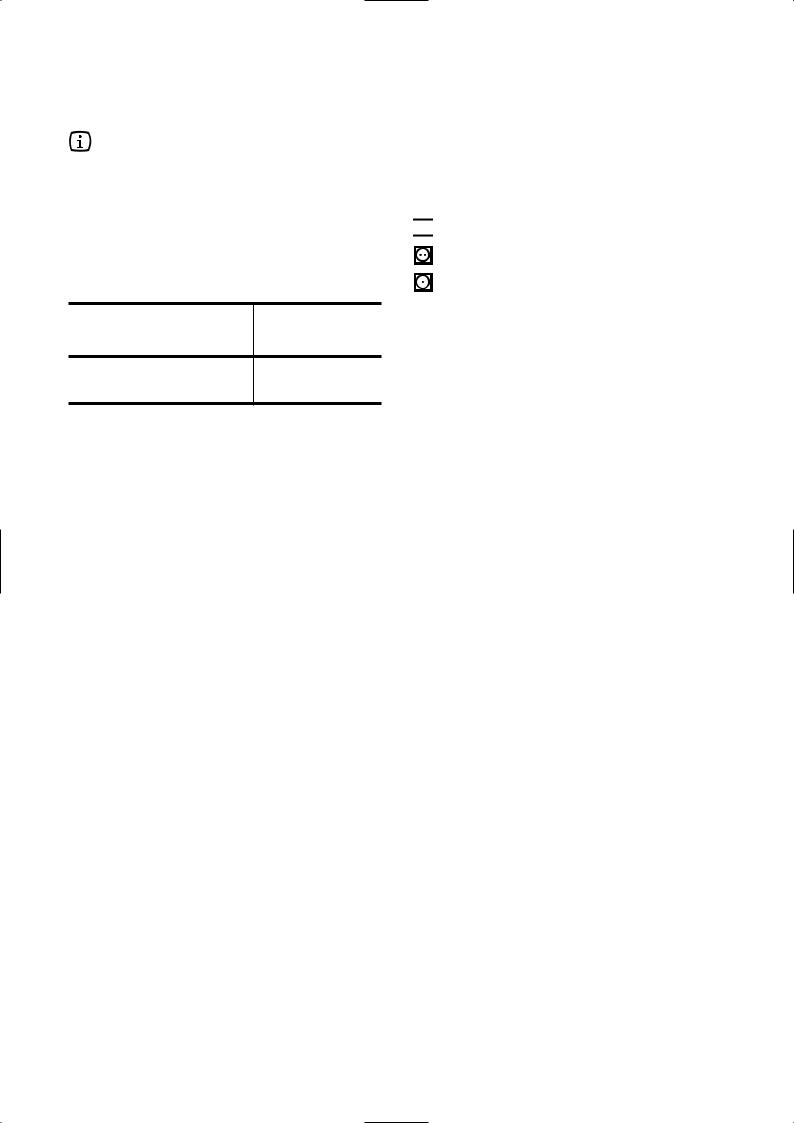
Drying hints
As a dryer, the machine works on the condensation principle.
Therefore, the water tap must be open and the drain hose must drain water into a sink or into the drain pipe, even during the drying cycle.
Load
Sort of laundry |
max. load |
|
(dry weight) |
||
|
||
Linen and cottons |
2.5 kg |
|
Synthetics |
2.5 kg |
Warning:
Loads of washed laundry exceeding these values must be divided before being dried, otherwise poor results will be obtained.
Garments not suitable for drying
ïParticularly delicate items such as synthetic curtains, woollen and silk, garments with metal inserts, nylon stockings, bulky garments such as anoraks, bedcovers, quilts, sleeping bags and duvets must not be machine dried.
ïGarments padded with foam-rubber or materials similar to foam-rubber must not be machine dried; they represent a fire hazard.
ïAlso, fabrics containing residues of setting lotions or hair sprays, nail solvents or similar solutions must not be machine dried in order to avoid the formation of harmful vapours.
Drying symbols on garment labels
Always look at the garment label to check whether garments can be machine dried.
The following symbols refer to drying:
 Machine drying is usually possible
Machine drying is usually possible
Normal drying (normal temperature)
Gentle drying (reduced temperature)
 Do not machine dry
Do not machine dry
Duration of the drying cycle
The drying time can vary according to
ïthe final spin speed;
ïthe required degree of drying (store dry or iron dry);
ïthe type of laundry;
ïthe size of load.
The usual drying times are indicated in the programme chart. As you become more familiar with the appliance, you will discover the drying times that best suit your needs according to the various type of fabric. It is a good idea to make a note of these times.
Fibre residue
After drying fluffy fabrics, such as new towels, it is advisable to perform the rinse programme N to be sure that any residue that may remain in the tub is completely removed and does not stick to garments dried afterwards.
After each drying cycle the filter should be checked and cleaned.
Additional drying
Should the laundry still be too wet at the end of the programme, set another short drying cycle.
Warning! To prevent the formation of creases or shrinking of fabrics, avoid excessive drying.
10
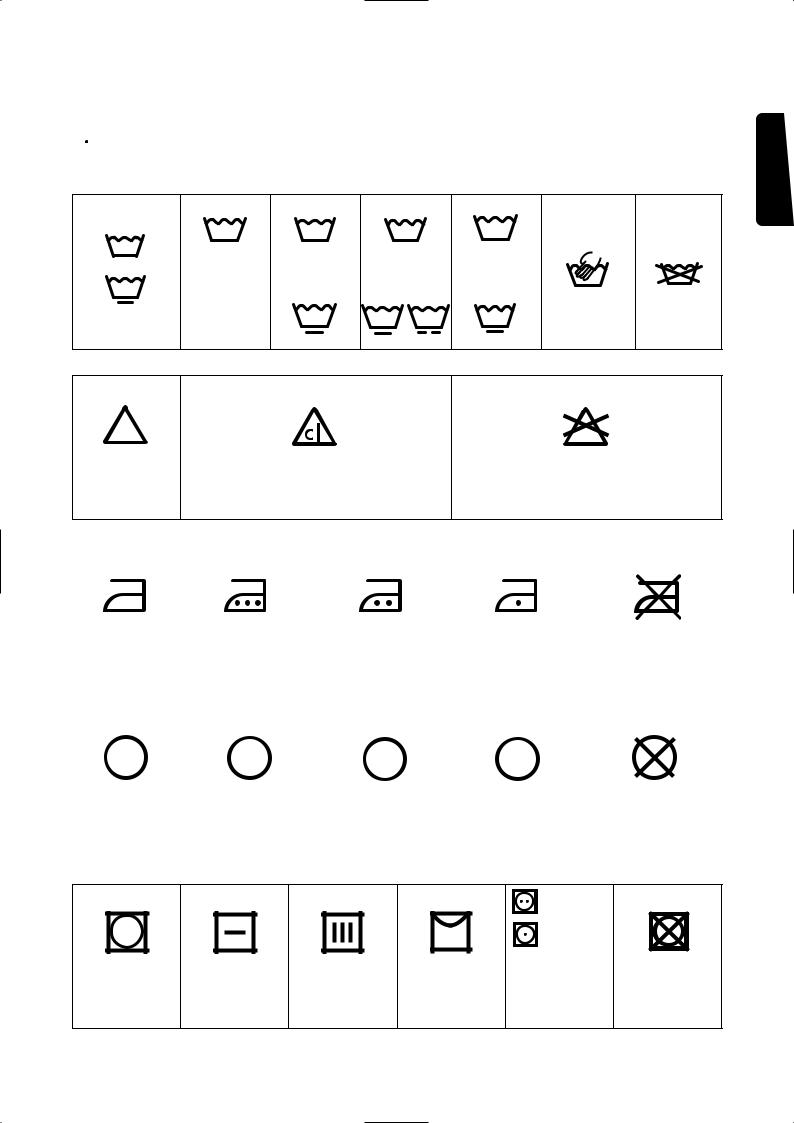
 International wash code symbols
International wash code symbols
These symbols appear on fabric labels, in order to help you choose the best way to treat your laundry.
Energetic wash |
|
|
|
30 |
|
95 |
60 |
|
40 |
|
|
Max. wash |
Max. wash |
Max. wash |
Max. wash |
|
|
temperature |
temperature |
temperature |
temperature |
|
|
95° C |
60° C |
|
40° C |
30° C |
|
|
60 |
|
|
Hand wash |
Do not |
Delicate wash |
40 |
40 |
30 |
wash |
|
|
|
|
|
|
at all |
Bleaching |
Bleach in cold water |
Do not bleach |
Ironing |
Hot iron |
Warm iron |
Lukewarm iron |
Do not iron |
|
max 200° C |
max 150° C |
max 110° C |
|
|
|
|
|
|
|
A |
P |
F |
|
Dry cleaning |
Dry cleaning |
Dry cleaning in |
Dry cleaning |
Do not |
|
in all solvents |
perchlorethylene, |
in petrol, |
dry clean |
|
|
petrol, pure alcohol, |
pure alcohol |
|
|
|
R 111 & R 113 |
and R 113 |
|
|
|
|
|
|
high |
temperature |
low |
temperature |
Drying |
Flat |
On the line |
On clothes |
Tumble dry |
Do not |
|
|
|
hanger |
|
tumble dry |
ENGLISH
11
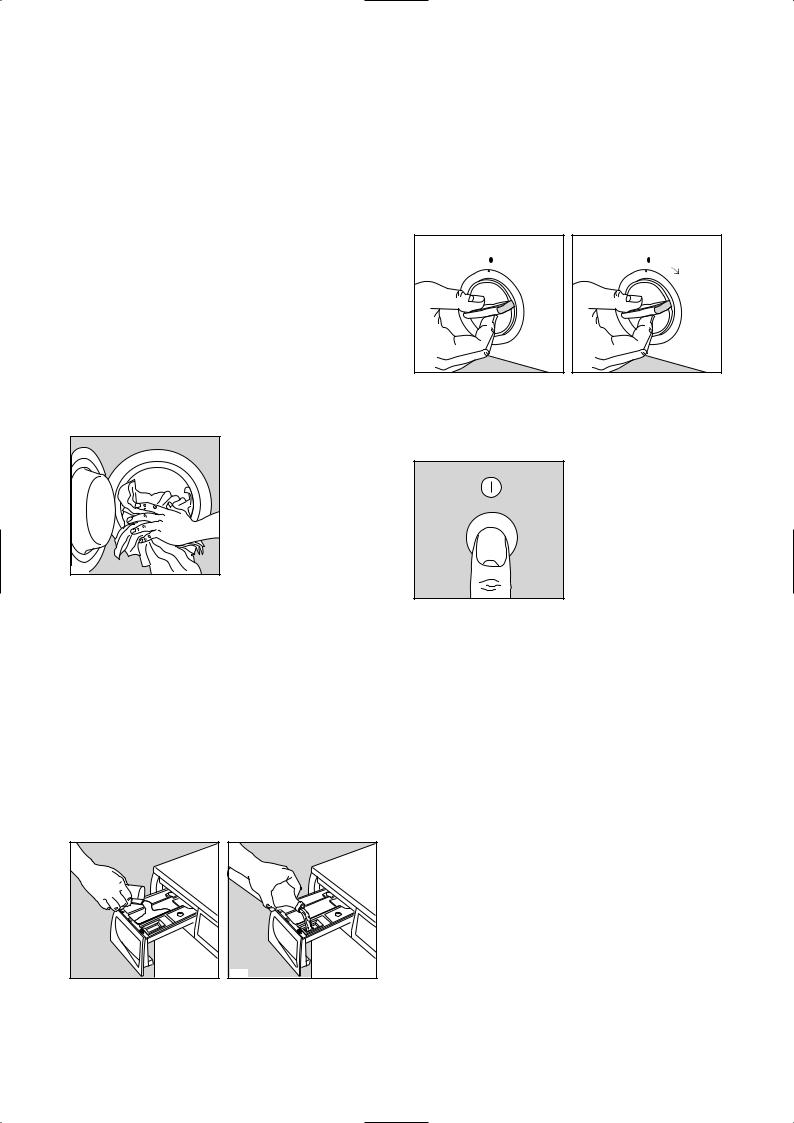
 Operating sequence
Operating sequence
Washing only
Before washing your first load of laundry, we recommend that you run a cotton cycle at 60°C, with the machine empty, in order to remove any manufacturing residue from the drum and tub.
Pour half a measure of detergent into the main wash compartment and start up the machine.
1. Place the laundry in the drum
Open the door.
Place the laundry in the drum, one item at a time, shaking them out as much as possible.
Close the door.
P0004
2. Measure out the detergent
Pull out the dispenser drawer until it stops. Measure out the amount of detergent recommended by the manufacturer in a graduated cup and pour it into the main wash compartment  .
.
If you wish to carry out the prewash, pour detergent into the appropriate compartment marked  .
.
3. Measure out the additive
If required, pour fabric softener into the compartment marked  , without exceeding the ´MAXª mark.
, without exceeding the ´MAXª mark.
C0064 |
C0065 |
4. Depress button  if required
if required
5. Select the temperature and the required programme
Turn the dial to the required temperature and the programme selector dial clockwise to the desired position.
95 |
M0045 |
B |
M0046 |
6. Start the machine
Depress the ON/OFF button: the mains-on light will illuminate and the machine starts operating.
P0080
7. At the end of the programme
The machine stops automatically.
If you have selected a programme which ends with the water of the last rinse in the tub, drain the water before opening the door by selecting programme P (drain) or J (drain and short spin).
The door is controlled by a safety device which releases 2 minutes after the end of the programme.
Switch the machine off by pressing the ON/OFF button  . The mains-on light goes out.
. The mains-on light goes out.
Remove the laundry from the drum and carefully check that the drum is empty so as to avoid any forgotten items being damaged in a subsequent wash (e.g. shrinking) or their colour running into a load of whites.
If you do not intend to carry out another wash, close the water tap.
Leave the door open to prevent the formation of mildew and unpleasant smells.
12

Washing Programmes
Programmes for cotton and linen
Wash programme |
Degree of soil |
Programme/ |
|
Description |
|
Possible |
Max. |
|||
and type of laundry |
Temperature |
|
|
option |
load |
|||||
|
|
|
|
|
|
|||||
|
|
|
|
|
|
|
|
|
|
|
|
|
|
|
|
|
|
|
|
|
|
WHITES |
|
A |
|
Prewash at 40 °C |
|
|
|
|
|
|
|
|
|
|
|
|
|
||||
For heavy soiled |
|
Wash at 60-95°C |
|
|
|
|
5 kg |
|||
WITH |
|
|
|
|
|
|
||||
cotton items. |
60°-95° |
|
3 rinses |
|
|
|
|
|||
PREWASH |
|
|
|
|
|
|
||||
|
|
Long spin |
|
|
|
|
|
|||
|
|
|
|
|
|
|
|
|
|
|
|
|
|
|
|
|
|
|
|
|
|
|
|
|
|
|
|
|
|
|
|
|
|
|
|
|
|
|
|
|
|
|
|
|
White cotton, for |
|
|
|
|
|
|
|
|
|
|
|
|
|
|
|
|
|
|
|
|
WHITES |
example normally |
B |
|
Wash at 60°-95 °C |
|
|
|
|
|
|
soiled work garments, |
|
|
|
|
|
|
||||
WITHOUT |
|
|
3 rinses |
|
|
|
|
5 kg |
||
sheets, household |
60°-95° |
|
|
|
|
|
||||
PREWASH |
|
Long spin |
|
|
|
|
|
|||
linen, underwear, |
|
|
|
|
|
|
||||
|
|
|
|
|
|
|
|
|
|
|
|
towels. |
|
|
|
|
|
|
|
|
|
|
|
|
|
|
|
|
|
|
|
|
|
Coloured cotton or |
B (*) |
|
|
|
|
|
|
|
|
|
|
Wash at 30°-60 °C |
|
|
|
|
||||
COLOUREDS |
linen fabrics, shirts, |
|
|
3 rinses |
|
|
|
5 kg |
||
|
underwear, towels, |
30°-60° |
|
Long spin |
|
|
|
|
||
|
blouses |
|
|
|
|
|
||||
|
|
|
|
|
|
|
|
|
|
|
|
|
|
|
|
|
|
|
|
|
|
|
|
|
|
|
|
|
|
|
|
|
|
Separate rinse cycle |
|
|
|
|
|
|
|
|
|
RINSES |
C |
|
4 rinses |
|
|
|
|
|
|
|
for hand washed |
|
|
|
|
|
5 kg |
||||
|
Long spin |
|
|
|
|
|
||||
|
cotton and linen items |
|
|
|
|
|
|
|
||
|
|
|
|
|
|
|
|
|
|
|
|
|
|
|
|
|
|
|
|
|
|
|
|
|
|
|
|
|
|
|
|
|
LONG SPIN |
Separate spin for |
D |
|
|
|
|
|
|
|
5 kg |
|
Long spin |
|
|
|
|
|
||||
cotton and linen items |
|
|
|
|
|
|||||
|
|
|
|
|
|
|
|
|
|
|
|
|
|
|
|
|
|
|
|
|
|
|
|
|
|
|
|
|
|
|
|
|
(*)This programme at 60°C is the reference programme for the Energy label according to EEC Directive 92/75.
Important!
ïProgramme B begins with a short drain, then the programme selector dial advances automatically to the water filling position.
ïWe suggest you not to switch the appliance off and on during its operation. This would modify the memorised programme in progress with unsatisfactory washing results.
ENGLISH
13

Washing Programmes
Programmes for synthetics, mixed fabrics, delicates and wool
Wash programme |
Degree of soil |
Programme/ |
|
|
Description |
Possible |
Max. |
|||
and type of laundry |
Temperature |
|
|
|||||||
|
|
|
|
|
|
option |
load |
|||
|
|
|
|
|
|
|
|
|
|
|
|
Synthetic or mixed |
|
|
|
|
|
|
|||
SYNTHETIC |
G |
|
Prewash at 40° C |
|
|
|
|
|||
fabrics, underwear, |
|
Wash at 30°-60° C |
|
|
|
|
||||
FABRICS |
coloured garments, |
|
|
3 rinses |
|
|
|
2.5 kg |
||
WITH |
30°-60° |
|
|
|
||||||
non-shrink shirts, |
|
Stop with water left |
|
|
|
|
|
|||
PREWASH |
|
|
|
|
|
|||||
blouses. |
|
|
in tub |
|
|
|
|
|
||
|
|
|
|
|
|
|
||||
|
|
|
|
|
|
|
|
|
|
|
|
|
|
|
|
|
|
|
|
|
|
|
|
|
|
|
|
|
|
|
|
|
SYNTHETIC |
Normally soiled |
H |
|
|
Wash at 30°-60°C |
|
|
|
|
|
FABRICS |
synthetic or mixed |
|
|
3 rinses |
|
|
2.5 kg |
|||
|
|
|
|
|
||||||
WITHOUT |
fabrics, shirts, |
30°-60° |
|
|
Stop with water left |
|
|
|||
|
|
|
|
|
|
|||||
PREWASH |
blouses, underwear |
|
|
in tub |
|
|
|
|
||
|
|
|
|
|
|
|
||||
|
|
|
|
|
|
|
|
|
|
|
|
|
|
|
|
|
|
|
|||
|
|
|
|
|
|
|
|
|||
SHORT |
Separate spin for |
J |
|
Draining of water |
|
|
2.5 kg |
|||
SPIN |
delicate items |
|
and short spin |
|
|
|
||||
|
|
|
|
|
|
|||||
|
|
|
|
|
|
|
|
|
|
|
|
|
|
|
|
|
|
|
|
|
|
|
Specially tested |
|
|
|
|
|
|
|
|
|
|
|
|
|
|
|
|
|
|
|
|
WOOL |
programme for wool |
L |
|
Wash at 30°-40°C |
|
|
|
|
|
|
|
garments bearing the |
|
3 rinses |
|
|
|
2 kg |
|||
|
|
|
|
|
|
|||||
|
ìPure new wool, non- |
|
|
Stop with water left |
|
|
|
|||
|
30°-40° |
|
|
|
|
|
|
|||
|
shrink, machine |
|
in tub |
|
|
|
|
|
||
|
washableî label. |
|
|
|
|
|
|
|
|
|
|
|
|
|
|
|
|
|
|
|
|
|
|
|
|
|
|
|
|
|
|
|
|
|
M |
|
Wash at 30°-40°C |
|
|
|
|
|
|
DELICATES |
Delicate fabrics, for |
|
3 rinses |
|
|
|
2.5 kg |
|||
|
|
|
|
|
||||||
example curtains |
30°-40° |
|
Stop with water left |
|
|
|
||||
|
|
|
|
|
|
|
||||
|
|
|
in tub |
|
|
|
|
|
||
|
|
|
|
|
|
|
|
|
|
|
|
|
|
|
|
|
|
|
|||
|
This programme can |
|
|
|
|
|
|
|
|
|
|
|
|
3 rinses, with fabric |
|
|
|
|
|||
RINSES |
be used for rinsing |
N |
|
softener, if required |
|
|
2.5 kg |
|||
hand washed |
|
Stop with water left |
|
|
|
|||||
|
|
|
|
|
|
|
||||
|
garments. |
|
|
in tub |
|
|
|
|
||
|
|
|
|
|
|
|
|
|
|
|
|
|
|
|
|
|
|
|
|
|
|
|
For emptying out the |
|
|
|
|
|
|
|
|
|
|
P |
|
Draining of water |
|
|
|
|
|
||
DRAIN |
last rinse water of |
|
|
|
- |
|
||||
|
|
|
|
|
|
|
||||
|
these programmes. |
|
|
|
|
|
|
|
|
|
|
|
|
|
|
|
|
|
|
|
|
|
|
|
|
|
|
|
|
|
|
|
At the end of these programmes, the last rinse water is not emptied out, so as to avoid creasing of the fabrics. To empty out the water, select programme J or P.
Important: When the automatic NON-STOP washing plus drying programme is used, the water is emptied out automatically and there is a short spin at 850 rpm before drying starts.
Important!
ïProgramme H for synthetics and L for wool begin with a short drain, then the programme selector dial advances automatically to the water filling position.
ïWe suggest you not to switch the appliance off and on during its operation. This would modify the memorised programme in progress with unsatisfactory washing results.
14

Programme table
Timed drying
Degree of |
Type of fabric |
Max. load |
Spin speed |
Drying time |
||
drying |
|
mins |
||||
|
|
|
|
|||
|
|
|
|
|
|
|
|
|
Cotton and linen |
2.5 kg |
850 |
Black section |
|
|
|
90 |
||||
|
|
(towels, T-shirts, |
|
|
||
|
|
|
|
|
||
Store dry |
(*) |
bathrobes) |
|
|
|
|
1 kg |
850 |
60 |
||||
Programme F |
||||||
Suitable for |
|
|
|
|
|
|
items to put |
|
|
|
|
|
|
|
|
|
|
Grey section |
||
away without |
|
Synthetic and mixed |
2,0 kg |
850 |
||
ironing |
|
fabrics (jumpers, |
110 |
|||
|
|
|
||||
|
|
blouses, underwear, |
|
|
|
|
|
|
|
|
|
||
|
|
household linen) |
1,0 kg |
850 |
70 |
|
|
|
Programme K |
||||
|
|
|
|
|
||
|
|
|
|
|
|
|
|
|
Cotton and linen |
2.5 kg |
850 |
Black section |
|
Iron dry |
|
70 |
||||
|
(sheets, tablecloths, |
|
|
|||
|
|
|
|
|||
Suitable for |
|
shirts, etc.) |
|
|
|
|
|
|
|
|
|||
ironing |
|
Programme F |
1 kg |
850 |
50 |
|
|
|
|||||
|
|
|
|
|
|
|
(*) The STORE DRY drying programme for cotton is the reference programme for the Energy Label data, in compliance with EC directive 92/75.
Drying only
Warning! Do not exceed the maximum laundry loads:
-2.5 kg for linen and cottons
-2.0 kg for synthetics.
The water tap must be open and the drain hose must be positioned in the sink or connected to the drain pipe.
1.Load the laundry
2.Select the drying programme F (for cotton) or K (for synthetics).
3.Select the drying time in the black or grey section of the selector, according to the fabrics (cotton or synthetics) to dry.
4.Press the ON/OFF button  to start the programme.
to start the programme.
5.At the end of the cycle press the ON/OFF button again to switch the appliance off.
6.Remove the laundry.
Automatic washing and drying (NON-STOP programme)
Warning! For NON-STOP programmes, it is also essential not to exceed the maximum load sizes of 2.5 kg for cotton and 2 kg for synthetics.
1.Load the laundry.
2.Add detergent and additive.
Do not use dosing device/ball when carrying out a NON-STOP programme. The plastic material with which it is made cannot withstand the high temperature in the drum during drying.
3.Select the wash programme.
4.Select the drying time.
5.Start the programme by depressing the ON/OFF button  .
.
6.At the end of the programme press the ON/OFF button again to switch the machine off.
7.Remove the laundry.
ENGLISH
15
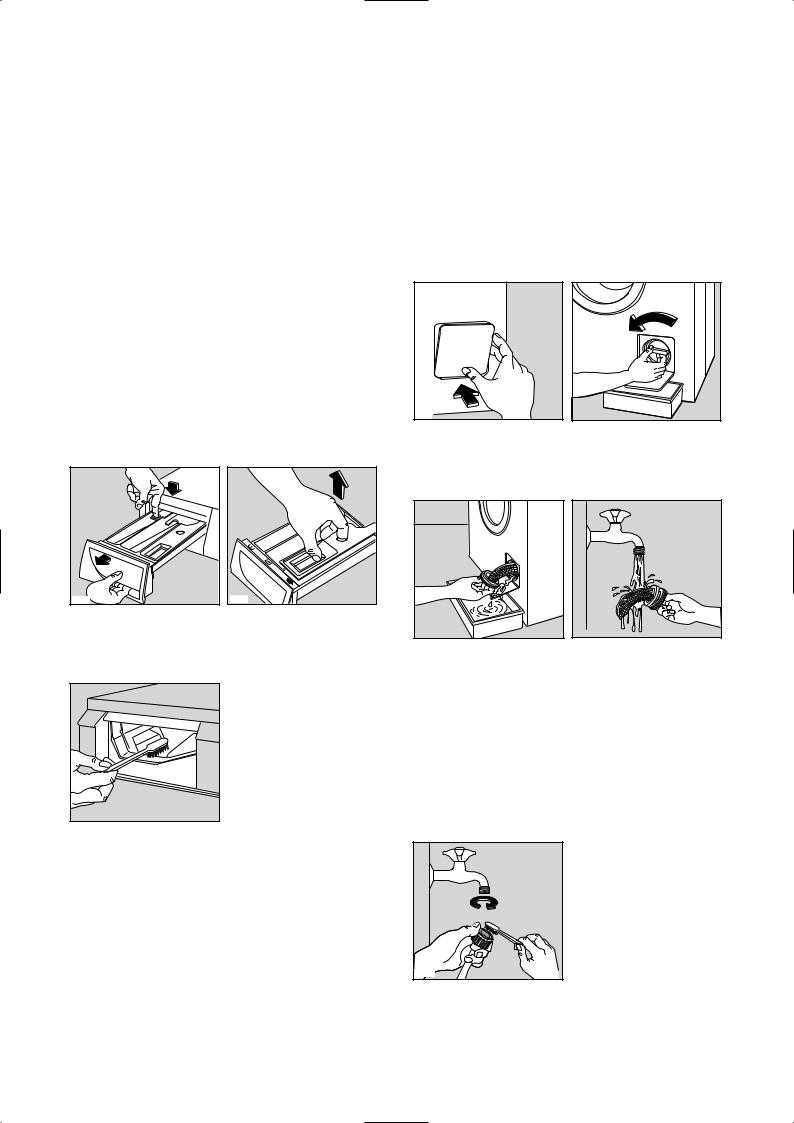
Maintenance
1. Bodywork
Clean the outside of the machine with warm water and a detergent used to handwash dishes. Rinse with clean water and dry with a soft cloth.
Important: do not use methylated spirits, solvents or similar products to clean the bodywork.
2. Detergent dispenser drawer
After a while, detergents and fabric softeners leave deposits in the drawer.
Clean the drawer from time to time by rinsing it under a running tap. To remove the drawer from the machine, press the button in the rear left-hand corner.
To facilitate cleaning, the top part of the additive compartments can be removed.
C0066 |
Detergent can also accumulate inside the drawer recess: clean it with an old toothbrush. Refit the drawer after cleaning.
P0038 |
3. Drain filter
The drain filter collects threads and small objects inadvertently left in the laundry. Check regularly that the filter is clean.
Open the filter door.
Place a container under the filter and unscrew it.
P0011 |
P0132 |
Pull out the filter.
Clean the filter under a running tap, then refit it, screwing it fully in.
P0133 |
P0040 |
4. Water inlet filter
If you notice that the machine is taking longer to fill, check that the filter in the water inlet hose is not blocked.
Turn off the water tap. Unscrew the hose from the tap.
Clean the filter with a stiff brush. Screw the hose back onto the tap.
P1090 |
16

5. Emergency emptying out
If the water is not discharged (outlet pump is blocked, filter or drain hose are clogged), proceed as follows to empty out the machine:
ïpull out the plug from the power socket;
ïclose the water tap;
ïif necessary, wait until the water has cooled down;
ïplace a bowl on the floor under the filter;
ïslightly loosen the filter to let the water come out slowly;
ïat the end screw the filter again.
6. Frost precautions
If the machine is installed in a place where the temperature could drop below 0°C, proceed as follows:
ïClose the water tap and unscrew the water inlet hose from the tap.
ïPlace the end of the drain hose and that of the inlet hose in a bowl placed on the floor.
ïSelect programme ìPî (draining) and run it until the machine stops.
ïSwitch the machine OFF by depressing button  .
.
ïScrew the water inlet hose back on and put the drain hose back in its place.
By doing this, any water remaining in the machine is removed, avoiding the formation of ice and, consequently, breakage of the affected parts.
When you use the machine again, make sure that the ambient temperature is above 0°C.
ENGLISH
17

Something not working?
Problems which you can resolve yourself.
|
Problem |
Possible cause |
|
|
|
ï |
The machine does not start up: |
ï The door is not firmly closed. |
|
|
ï The machine is not plugged in or there is no power |
|
|
at the socket. |
|
|
ï The main fuse has blown. |
|
|
ï The programme selector dial is not positioned |
|
|
correctly. |
|
|
ï The ON/OFF button has not been depressed. |
|
|
|
ï |
The machine does not fill: |
ï The water tap is closed. |
|
|
ï The inlet hose is squashed or kinked. |
|
|
ï The filter in the inlet hose is blocked. |
|
|
ï The door is not properly closed. |
|
|
|
ï |
The machine fills then empties |
ï The end of the drain hose is too low. Refer to |
|
immediately: |
relevant paragraph in ìwater drainageî section. |
|
|
|
|
|
|
ï |
The machine does not empty |
ï The drain hose is squashed or kinked. |
|
and/or does not spin: |
ï A programme which ends with water in tub has |
|
been selected. |
|
|
|
ï The drain filter is clogged. |
ï There is water on the floor: |
ï Too much detergent or unsuitable detergent |
|
|
|
(creates too much foam) has been used. |
|
|
ï Check whether there are any leaks from one of the |
|
|
inlet hose fittings. It is not always easy to see this |
|
|
as the water runs down the hose; check to see if it |
|
|
is damp. |
|
|
ï The drain hose is damaged. |
|
|
|
ï |
Unsatisfactory washing results: |
ï Too little detergent or unsuitable detergent has |
|
|
been used. |
|
|
ï Stubborn stains have not been treated prior to |
|
|
washing. |
|
|
ï The correct temperature was not selected. |
|
|
ï Excessive laundry load. |
|
|
|
ï |
The machine vibrates or is |
ï The transit bolts and packing have not been |
|
noisy: |
removed. |
|
ï The support feet have not been adjusted. |
|
|
|
ï The laundry is not evenly distributed in the drum. |
|
|
ï Maybe there is very little laundry in the drum. |
ï |
The door will not open: |
ï The programme is still running. |
|
|
ï The door lock has not been released. |
|
|
ï There is water in the drum. |
|
|
|
|
|
|
18

|
Problem |
Possible cause |
|
|
|
ï Spinning starts late or the |
ï The electronic unbalance detection device has cut |
|
|
laundry is not spun enough: |
in because the laundry is not evenly distributed in |
|
the drum. The laundry is redistributed by reverse |
|
|
|
rotation of the drum. This may happen several |
|
|
times before the unbalance disappears and normal |
|
|
spinning can resume. If, after 20 minutes, the |
|
|
laundry is still not evenly distributed in the drum, |
|
|
the machine will not spin. If at the end of the |
|
|
programme the laundry is not spun enough, |
|
|
redistribute the load manually and select the spin |
|
|
programme. |
|
|
|
ï Water is not visible in the |
ï The machine, which is the result of modern |
|
|
machine. |
technology, runs in a very economical way with low |
|
water consumption. Performance is nevertheless |
|
|
|
excellent. |
|
|
|
ï |
The machine makes an unusual |
ï The machine is fitted with a commutator motor |
|
noise. |
which improves machine performance. |
|
|
|
|
|
|
ï |
The machine will not dry or the |
ï The water tap is closed. |
|
laundry is not dry enough |
ï The drain filter is clogged. |
|
ï The drying time has not been selected. |
|
|
|
|
|
|
ï An appropriate drying time has not been chosen. |
|
|
ï There is too much laundry inside the appliance. |
|
|
|
ENGLISH
If you are unable to identify or solve the problem, contact our service centre. Before telephoning, make a note of the model, serial number and purchase date of your machine: the Service Centre will require this information.
P0042 |
19
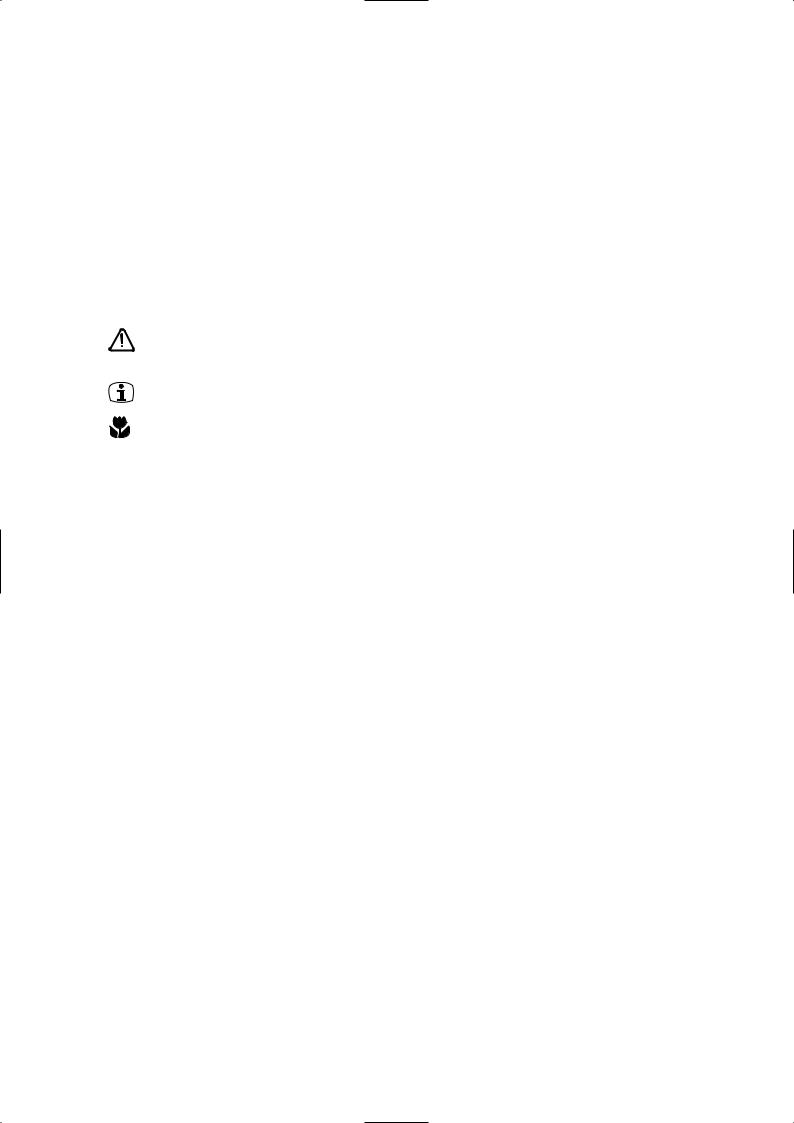
Bästa kund,
vi ber dig att läsa igenom den här bruksanvisningen noggrant.
Framför allt är det viktigt att du läser säkerhetsinformationen på de första sidorna i bruksanvisningen. Förvara alltid bruksanvisningen lättillgänglig, så att du snabbt kan hitta den och slå upp information i den vid ett senare tillfälle. Om du säljer maskinen ska bruksanvisningen överlämnas till nästa ägare.
Transportskador
Kontrollera att maskinen inte är skadad. Eventuella transportskador skall omedelbart anmälas till den som ansvarat för transporten. Skador, felaktigheter och ev. saknade delar skall omedelbart anmälas till säljaren.
Så här använder du bruksanvisningen
Några stycken i bruksanvisningen är försedda med en symbol. Dessa symboler betyder följande:
Här finns viktig information om olämplig användning av maskinen som skulle kunna förorsaka personoch egendomsskada.
Här finns information, som är särskilt viktig för att erhålla bästa möjliga tvättoch torkresultat.
Här finns viktiga miljöoch energispartips.
Vårt bidrag till miljöskyddet är att vi använder returpapper.
Innehållsförteckning
Viktig säkerhetsinformation
Bortskaffning/avfallshantering
Energisparråd
FÖR ANVÄNDAREN
Beskrivning av maskinen
Bruk
Kontrollpanel
Beskrivning av maskinens panelfunktioner
Viktiga råd och tips för dig som tvättar
Sortering av tvätt Temperaturer
Hur mycket tvätt per omgång? Tvättmedel och tillsatser Tvättmärkning
Viktiga råd och tips för dig som torkar
Vikt
Tvättgods som inte bör torkas Torksymboler på tvättmärken Torkningens längd
Extra torkning Fiberrester
Så här använder du maskinen
Lägg i tvätten
Fyll på tvättmedel och tillsätt sköljmedel Välj önskad temperatur
Välj önskat program och starta maskinen Avslutat program
Programöversikt: Tvätt
21 |
Programöversikt: Torkning |
30 |
|
22 |
Manuell torkning |
30 |
|
22 |
Tvätt och torkning i ett |
30 |
|
Skötsel och rengöring |
31 |
||
|
|||
|
Rengöring av höljet |
31 |
|
22 |
Rengöring av tvättmedelslådan |
31 |
|
23 |
Rengöring av lådöppningen |
31 |
|
Rengöring av avloppssilen |
31 |
||
23 |
|||
Rengöring av tilloppsslangens filter |
31 |
||
23 |
|||
Rengöring av maskinen |
32 |
||
24 |
|||
Avkalkning av maskinen |
32 |
||
24 |
|||
Nödtömning |
32 |
||
24 |
|||
Åtgärd vid frysrisk |
32 |
||
24 |
|||
Om maskinen inte fungerar |
33-34 |
||
24-25 |
|||
Service och reservdelar |
35 |
||
25 |
|||
Konsumentrådgivning |
35 |
||
26 |
|||
Garanti (gäller för Finland) |
35 |
||
26 |
|||
|
|
||
26 |
FÖR INSTALLATÖREN |
|
|
26 |
Tekniska data |
35 |
|
26 |
|||
Installation |
36 |
||
26 |
|||
Uppackning |
36 |
||
26 |
|||
Tillbehör |
36 |
||
27 |
|||
Transportsäkring |
36 |
||
27 |
|||
Placering |
36 |
||
27 |
|||
Nivåjustering |
36 |
||
27 |
|||
Vattenanslutning |
37 |
||
27 |
|||
Avloppsanslutning |
37 |
||
27 |
|||
Elektrisk anslutning |
37 |
||
28-29 |
|||
|
|
20

 Viktig säkerhetsinformation
Viktig säkerhetsinformation
Följande varningsuppgifter är till för den allmänna säkerheten. Läs igenom dem noggrant före installation och användning av apparaten.
Installation
•Alla installationsarbeten på och ingrepp i produkten och elanslutningen skall utföras av behörig fackman. Ger du dig på produkten utan behörighet kan du försämra dess funktion och skada person och egendom.
•Se till att maskinen inte står på anslutningssladden och att inte avoch tilloppsslangarna har några veck, samt att underlaget är plant och stabilt.
•Maskinen får aldrig placeras på sockel, fundament eller liknande, eftersom det då finns risk för tippning under centrifugeringen.
•Använd inte din tvättmaskin för kemtvätt. Undvik att bleka och färga i maskinen. Tvättgods som innehåller starka kemikalier bör först sköljas ur i vatten innan det läggs in i tvättmaskinen.
Skador som uppstår på grund av punkterna ovan täcks inte av konsumentköplagen.
•Explosionsrisk: Torka aldrig tvätt som kommit
i kontakt med brandfarliga lösningsmedel (bensin, alkohol, fläckborttagningsmedel etc) eftersom dessa kemikalier kan orsaka en explosion på grund av sin flyktighet. Endast vattentvättad tvätt får torkas.
Användning
•Tvätt-/torkmaskinen är endast avsedd att användas för normal hushållstvätt enligt anvisningarna i denna bruksanvisning. Används den för andra ändamål finns det risk för personoch egendomsskada.
•Lägg aldrig tvättgods i trumman utan att först titta efter om den är tom.
•Överbelasta inte maskinen (se «Tvätttorkkapacitet»).
•En bygelbehå bör inte tvättas i maskinen, då en bygel som lossnat kan förstöra tvätten och fastna i tvättrumman.
•Föremål som t ex mynt, nålar, spikar och skruvar kan skada maskinen allvarligt. Se till att alla fickor är tömda och att knappar är uppknäppta och blixtlås är stängda innan du tvättar ett plagg.
•Små kläder såsom band, skärp och strumpor bör tvättas i en tvättpåse, eftersom de annars kan komma in mellan trumman och behållaren.
•Följ alltid tillverkarens rekommendationer för tvättoch sköljmedelsdosering. Överdosering kan skada maskinen och tvättgodset.
•I vissa länder säljs särskilda doseringsbehållare av plast som läggs i maskinen tillsammans med tvätten. Dessa plastbehållare måste tas bort före torkningen.
Underhåll/Service
•När du tvättat färdigt, stäng vattenkranen och tryck ut huvudströmbrytaren. Låt luckan stå lite öppen när maskinen inte används så att lucktätningen bibehåller sin smidighet.
•Service och reparationer skall utföras av ett serviceföretag som leverantören godkänt. Använd bara reservdelar som dessa säljer. Försök aldrig reparera maskinen själv.
Barnsäkerhet
•Barn förstår oftast inte hur farligt det kan vara att leka med elektriska maskiner. Därför ska du hålla uppsikt över maskinen under drift. Låt inte barnen leka med maskinen.
•Förpackningsmaterial (t ex plastfolie och frigolit) kan vara farligt för barn. Risk för kvävning! Se till att barnen inte kommer åt att leka med förpackningsmaterialet.
•Under tvätt och torkning kan glasluckan bli het. Låt därför inte barn vistas i närheten av maskinen under drift.
•Kontrollera att barn eller små djur inte tar sig in i maskinens trumma.
•Förvara tvättmedel på säker plats; oåtkomligt för barn.
•När maskinen är uttjänt och ska forslas bort, ska du dra ut stickkontakten och skära av nätkabeln. Stickkontakten och resterna av nätkabeln ska också kastas. Lucklåset ska förstöras. På så sätt kan lekande barn inte bli instängda i maskinen och försättas i livsfara.
SVENSKA
21
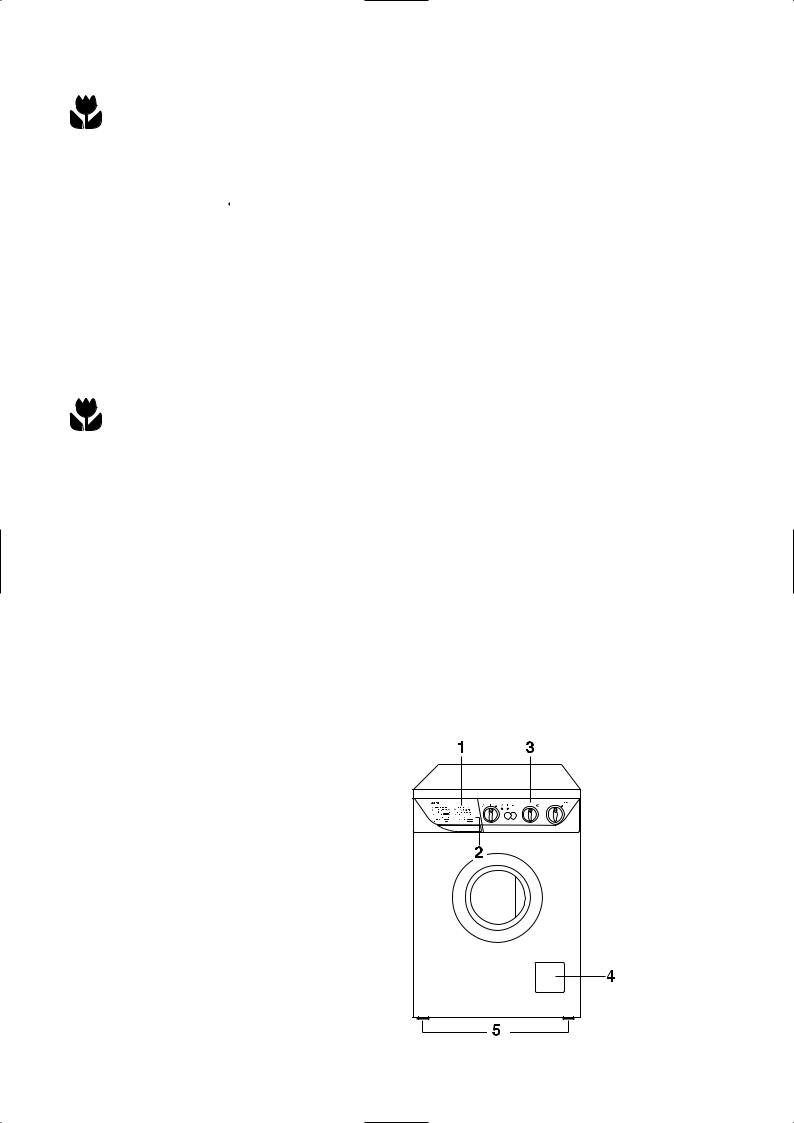
Bortskaffning/avfallshantering
Hantering av förpackningsavfall
De material i förpackningen som kan återanvändas är märkta med symbolen 
 och skall i princip återanvändas.
och skall i princip återanvändas.
>PE< står för polyeten
>PS< står för polystyrol
>PP< står för polypropylen
Pappemballaget bör läggas i en pappersinsamlingscontainer, om en sådan finns i ert område.
Deponering av uttjänt maskin
Kontakta din kommun för information om var du kan lämna din maskin.
Energisparråd
Allra sparsammast och miljövänligast tvättar man om man följer dessa tips:
•De bästa förbrukningsvärdena uppnås när maskinen är fylld (gäller både tvätt och torkning).
•Dosera tvättmedelsmängden efter vattnets hårdhet, plaggens nedsmutsningsgrad och tvättmängden.
•För normalt smutsad tvätt räcker det med ett tvättprogram utan förtvätt.
Beskrivning av maskinen
1Tvättmedelslåda
2Programkort
3Kontrollpanel
4Avloppssil
5Fötter för nivåjustering
•När du tvättar små mängder tvätt ska du bara använda hälften eller upp till två tredjedelar av den rekommenderade doseringen för tvättmedlet.
•Med rätt förbehandling kan fläckar och lätt smuts avlägsnas. Sedan kan tvätten tvättas på en lägre temperatur.
•Maskinen förbrukar mindre energi om tvätten är tillräckligt centrifugerad före torkningen.
22

Bruk
Kontrollpanel
SVENSKA
1 Tvättmedelslådan |
C0063 |
Fack för förtvättmedel
Fack för huvudtvättmedel
Fack för sköljmedel
2 Val av torktid 
Genom att vrida vredet medsols kan man ställa in torktiden för automatisk eller manuell torkning: svart fält: Torkning med normal temperatur (bomull) grått fält: Torkning med sänkt temperatur (syntet).
•Automatisk torkning (Non-stop-program) innebär att direkt efter avslutat tvättprogram startar torkningen.
Viktigt! Tänk på att fylla trumman med max. 2,5 kg vitoch kulörtvätt eller 2 kg syntettvätt.
•Manuell torkning väljs tillsammans med program F eller K.
Avkylning
Avkylningsfasen startar automatiskt 10 minuter före programmets slut, så tvättgodset kyls av.
Avkylningsfasen får under inga omständigheter avkortas, avbrytas eller uteslutas, då det kan medföra risk för förbränning!
3 Kontrollampa för torkning 
Denna lampa lyser, när maskinen genomför torkprogrammen F eller K.
4 Driftkontrollampa
Denna lampa tänds när maskinen startar, och den släcks när start/stoppknappen åter trycks in.
5 Start/stopp (strömbrytare) 
Tryck in knappen så startar programmet och driftkontrollampan tänds. Under programmets gång kan du trycka ut knappen för att lägga i glömd tvätt i trumman. Tryck åter på knappen så fortsätter programmet. Efter avslutat program skall knappen tryckas ut så att maskinen stängs av.
6 Halvfull maskin 
Tryck på denna knapp, när maskinen endast är fylld till hälften (2,5 kg bomull), för att därigenom använda mindre vatten vid sköljningarna.
7 Temperaturväljare 
Vrid vredet tills önskad tvättemperatur står under markeringen.
I programöversikten finns förslag på lämpliga temperaturer för olika program. Vredet kan vridas både medoch moturs.
När vredet står vid  sker ingen uppvärmning.
sker ingen uppvärmning.
8 Programväljare
Vrid vredet medurs tills önskat tvättoch torkprogram står under markeringen.
23
